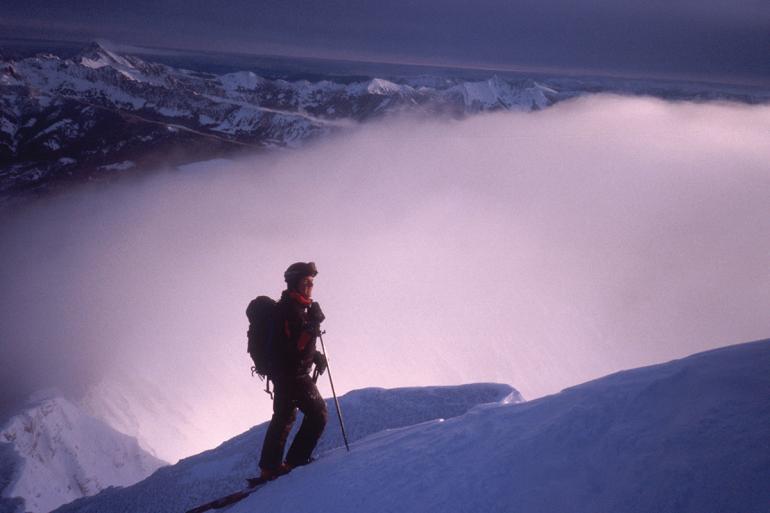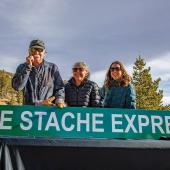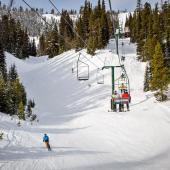Big Sky Ski Patrol
A woman's first season with the volunteer ski patrol.
“Dispatch.”
I’m always listening for the crackle of the radio, but can never quite get the volume control just right. It appears to me that the professional patrollers are much more adept at actually distinguishing the somewhat garbled speak and codes that come across channel one—I, myself, am still working on it.
“We have a 1050 on Elk Park just beyond Madison Avenue. Who can respond?”
I was there. Well, almost there. A 1050 was what we all waited for—the pros especially, but as first-year volunteers (or "vollys") it was all we could talk about: have you been on an accident yet? I told my mom I was hoping to get lucky today—she told me she was glad she didn’t ski. “Your kind of luck,” she said, “is something I don’t want to stick around for.”
I pulled off my right glove and clumsily felt for the radio that was seriously stuck in the upper left pocket of my overloaded, and required, patroller vest.
“Ibes. Elk Park. I’ll take it.”
“Dispatch copies.”
“Shit.” No, this didn’t go over the radio. As much as I both needed and wanted the experience of managing an accident on the hill, I was nervous as hell. Besides, radio etiquette is taken quite seriously here; the less chatter the better.
It took more than a few minutes to find my patient. In fact I almost skied past him, as he wasn’t quite in the position reported—in fact he was barely visible from the main run. When I came upon him he was sitting in the snow, skiers’ right. He was clutching the upper portion of his right leg, rocking back and forth, and moaning in pain.
I keyed the radio. “Dispatch this is Ibes. I found him. He’s in the meadow just beyond Madison Avenue.”
“Copy Ibes, let us know what you need.”
I clicked off my skis and stuck them upright in a cross behind us so we’d be more visible on the hill, then began the protocol that had been drilled into me.
“Hi, my name is Kim Ibes with Big Sky Ski Patrol. Can I help you?” This is when the litany begins. Identify yourself, ask if you can assist—you have to ask if you can assist—assess the situation (is the scene safe), take vitals (pulse, respirations), check for altered mental status, find out what happened, evaluate the injury, keep any witnesses in the area, update dispatch, order a sled, O2, trauma pack, splint, whatever you need… the list goes on.
This practice drill went off without a hitch, though my patient proved to be an ornery cuss—but what else could I expect from one of my trainers. After pulling him down in the sled several hundred feet we stop to set up once again, and the training continues—another volunteer steps up to the plate and this time I get to learn by watching.
A typical day on the Big Sky Ski Patrol—both volunteer and pro—starts on the hill around 7:30 am, with the exception of Snow Safety (only God knows when they get there). The first time I entered the ski patroller boot-up room, I was immediately taken back to the frat houses I’d partied in during my freshman year of college—from the interior decoration to the camaraderie, including the condition of the bathrooms, which for your benefit I won’t go into. It takes about 20 minutes to find a place to stow your gear, sign in, and get dressed: boots buckled, Pieps activated, shovel and probe ready to go, backpack, red jacket, black vest with its numerous pockets filled with various medical supplies (1 knife, 2 cravats, sheers, glucose, pocket mask, climbing harness, slings, etc.). The first-year vollys, or re-re’s as we’re affectionately called (the pros tell us they have to re-do everything we get into), have our little cubby in the boot-up room, and by the time we’re done it’s reminiscent of my brother’s high-school bedroom.
The veteran volunteers, some of whom have been on the Big Sky Ski Patrol for over 15 years, sign us up for the various posts: Andesite, the Lone Peak Triple, Challenger, Shedhorn, and Lone Peak itself. Lone Peak is the dream post, but if you’re a first-year volly, forget it. Beyond that, you’re only posted where you’ve been cleared to run a sled. And that, my friend, separates the women from the girls. Running a patient-loaded sled is one of the most physically demanding aspects of this job—be it on a steep or flat slope. The steeps often require a tail roper—a second ski patroller helping guide the sled with a rope attached at the end—here, solid communication and coordination skills are key. Familiarity of the ski terrain and practical drills on each run are necessities, especially in the flats. If you’re in the horns (the metal handles pulling the sled), it’s your responsibility to get your patient to the base. You have to know when to let the sled gain some speed to make it through these slower sections, which is challenging in heavy snow conditions.
Bob Dixon (Ski Patrol Director) and Jim Humphries (Assistant SPD) start our day promptly at 8:00 am, and with the exception of heavy snow-safety days, the room is packed and silent. Each morning they review the day’s conditions, provide avalanche updates, expected mountain temperatures, any possible lift closures, previous accidents, and each mountain supervisor follows up with their respective area. After the 20-minute-or-so meeting the volunteers check the board for posting assignments and head out the door to tackle “the hill.” Every morning at roughly 8:30 am we hike up the hill from the boot-up room to either Swifty or Ramcharger; and every evening between 4:30 and 5:00 we hike back up the hill from the other side to return to the boot-up room. The first time I’d put on all my gear—which I swear must weigh 100 pounds—and made it to the top of the hill, I thought I was going to die.
Naively, I thought being a ski patroller was more about skiing the hill, moving a few pieces of bamboo, and you know, occasionally hauling someone down on a sled… how hard could that be? After finishing my initial training I can tell you how hard it is: pulling a sled is incredibly hard work and sometimes a terrifying responsibility; avalanche training is a sobering experience that brings home the importance of making sure your out-of-bounds partner knows how in the hell to use his equipment; treating an accident victim (some with life-threatening injuries) will make even the un-studious student crack open a book and pay some serious attention to practical scenarios; and the incredible number of end-of-day sweeps (my favorite part) requires coordination, knowledge, and most of all a sense of responsibility for those who might have been left behind.
This is my first season as a Big Sky Volunteer Ski Patroller. I had no idea what I was in for when I signed up, but after a season on the hill, I will say that I can’t wait to come back next year. I thought I’d joined the patrol simply for the free unlimited passes—wake-up call. Patrolling is about so much more than the skiing. But honestly, I’m still really, really enjoying those free passes.
As a Big Sky skier, you’ll be happy to know that your patrollers (both pro and volunteer) have been well-trained to care for you in case you ever need them. The minimum requirement for a volunteer is to be a certified First Responder—this requires 80 hours of medical training and a state exam; many are also EMT-certified, which is the minimum for the pro staff. In addition, at the beginning of each year there is a multi-day medical refresher with on-the-hill training; and of course the training continues each day of the 16 required duty days during the season. All in all, not a bad trade-off for free Big Sky season passes for you and yours.
If you’re interested in finding out how you can be on the Big Sky Ski Patrol, call Brian Murphy, one of our volunteer coordinators, at 585-7875. Or participate in the March 13th “Ski with a Patroller Day.” Just don’t forget your lunch. The cardinal rule in ski patrol is to never leave your lunch above or below you.
See you on the hill — let’s hope it’s not on my lucky day.











